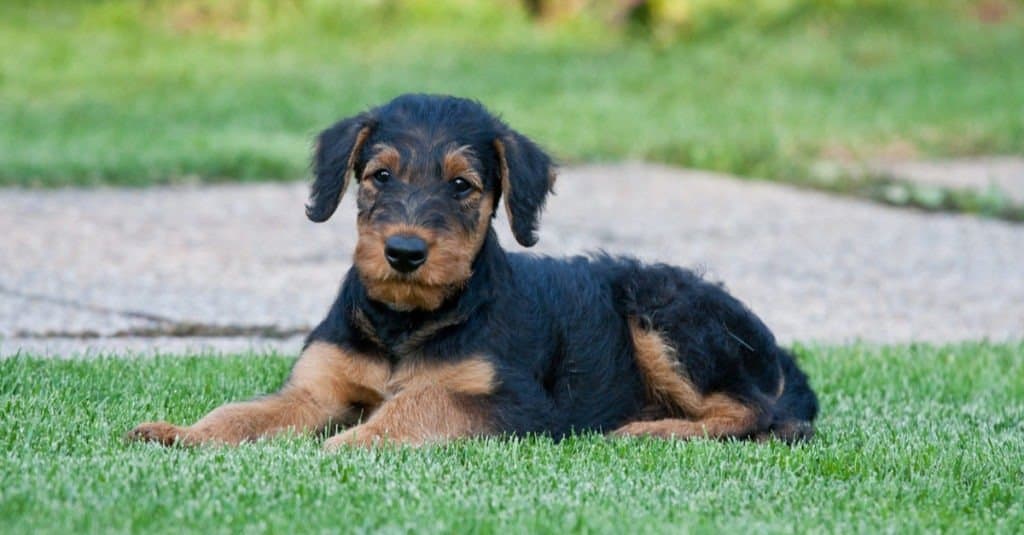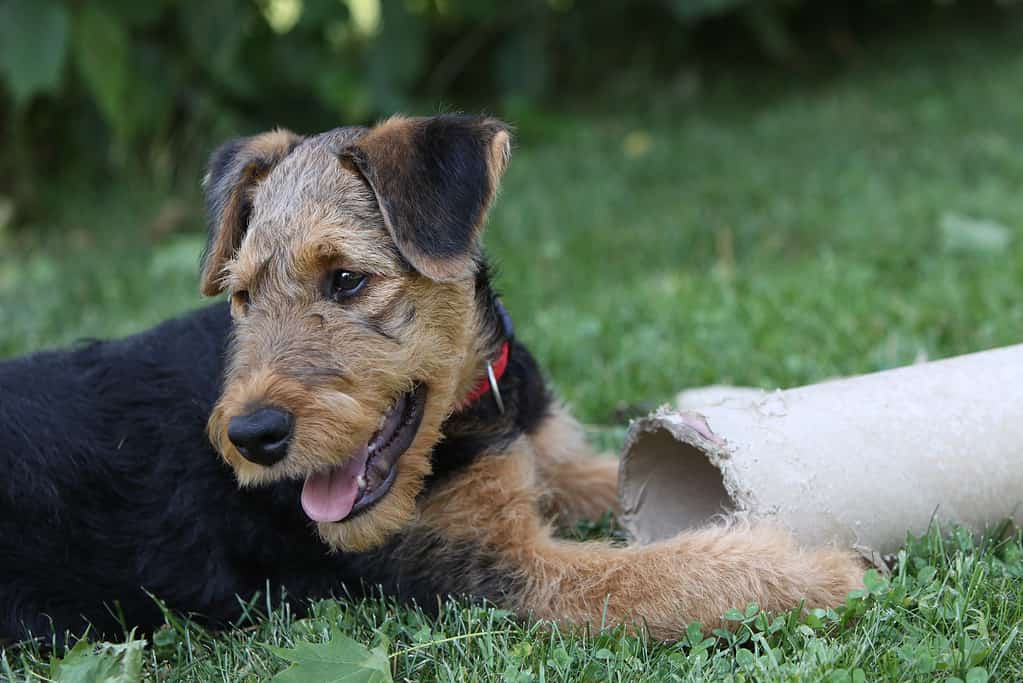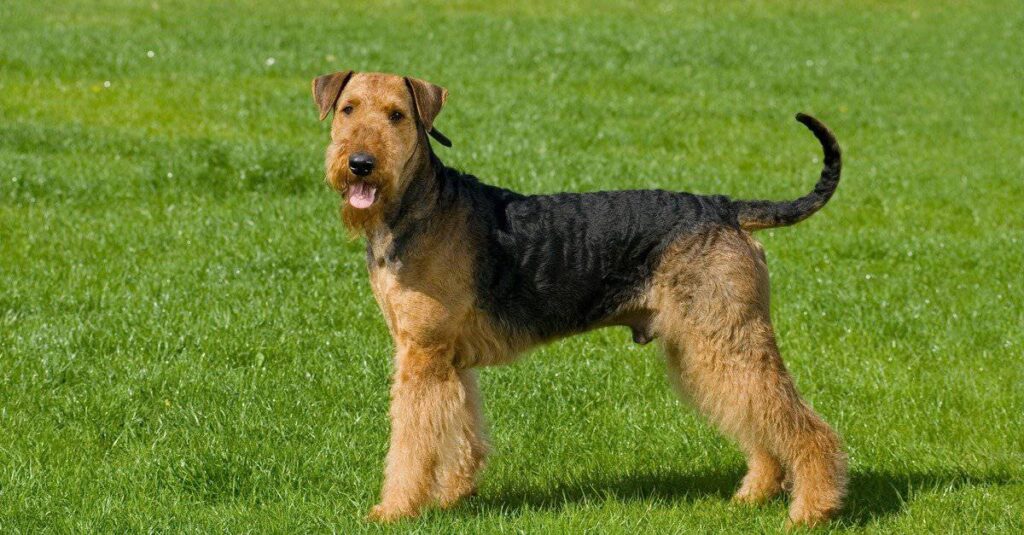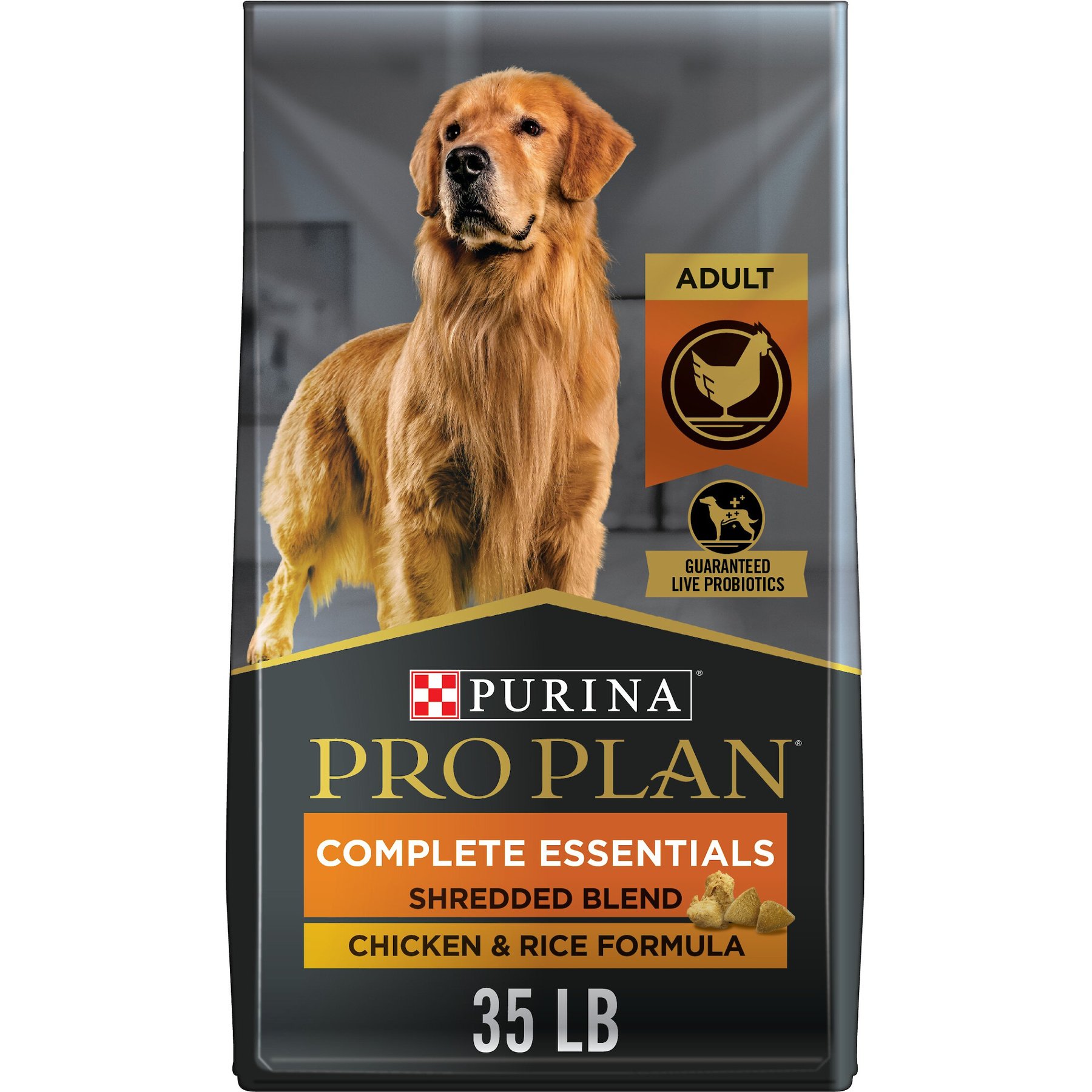Airedale Terrier Summary
The airedale terrier is often called the “King of Terriers” due to its large size and versatile skills. Often, this breed is known for being energetic (like most terriers) and confident. For more active individuals and families, they can make great companion animals. They’re also kept as working and hunting dogs, as they have a pretty high prey drive. However, they can be very spirited and difficult to train.
Airedale Terrier Growth and Weight Chart by Age
| Age | Female Weight | Male Weight |
|---|---|---|
| Newborn | 10-12 ounces | 10-12 ounces |
| 2 weeks | 1.5-2 pounds | 1.5-2 pounds |
| 4 weeks | 7-12 pounds | 7-12 pounds |
| 2 months | 12-20 pounds | 12-20 pounds |
| 3 months | 15-25 pounds | 15-25 pounds |
| 4 months | 20-35 pounds | 20-35 pounds |
| 5 months | 25-45 pounds | 25-45 pounds |
| 6 months | 30-45 pounds | 30-50 pounds |
| 9 months | 35-50 pounds | 40-55 pounds |
| 12 months | 40-60 pounds | 40-65 pounds |
| 18 months | 50-65 pounds | 55-70 pounds |
Keep in mind that every dog is unique, even within the same breed. Some may fall outside of these ranges and be completely normal. Furthermore, young dogs tend to grow in spurts. So, a dog may be under the range one week and then back within the normal range next week, depending on when, exactly, they were weighed.
We stuck with the AKC guidelines for this breed for this growth chart, but the standard varies widely depending on what kennel club you’re looking at. If you purchase your dog from a European breeder, their weight may not even be close to this chart.
When Will My Airedale Terrier Stop Growing?
Airedale terriers reach their full weight between 18 months and two years of age. Because they are larger terriers, they usually keep growing longer than other terrier breeds. Usually, dogs will reach their full height and be rather skinny before adding on some extra fat and muscle.
Therefore, even if your airedale has technically reached its full height, it may continue to gain pounds and muscle for a few months. Don’t feel the need to “fatten up” your puppy, even if they look a bit leggy, unless instructed to increase its calories by your vet.
To support its growth, you must feed your terrier a diet formulated for puppies. Puppies have special dietary needs that older dogs do not have, as they are still growing. Male airedale terriers should absolutely be fed puppy food designed for larger breeds (which have particular dietary needs compared to smaller breeds). In most cases, vets recommend females eat a large-breed formulation, too.
As always, follow the feeding guidelines on the back of the dog food container. You may need to adjust for your dog’s specific needs, but the back of the container is often a good place to start.
Regular check-ups are also essential for your terrier, as these help ensure they are growing at the proper rate. Dogs that grow too fast or too slow may be more prone to health conditions.
Dogs often need to have very regular check-ups when they are young, but these slowly lengthen to once a year. Work with your vet to come up with a schedule that works for your needs.
How Big Will My Airedale Terrier Be When It’s Fully Grown?

Airedale terriers are absolutely adorable as puppies, but you should be prepared for them to grow rather large!
©Lenkadan/Shutterstock.com
According to the AKC, airedale terriers should be about 50-70 pounds when fully grown. Often, there is an obvious size difference between the males and females of this breed. Therefore, females are usually in the 50s, while males are in the 60s.
However, airedale terriers tend to vary in weight more than other breeds. The UKC does not even list a weight guideline within its breed standard. The French Kennel Club also does not list weight as a primary characteristic of this breed. However, this club also puts the height maximum a full 10 cm higher than most other clubs.
Based on this, where you get your dog from can make them much larger or smaller. Dogs in the United States tend to be smaller than the airedale terriers in Europe, based on the accepted standards.
When Should My Airedale Terrier Be Spayed or Neutered?
There are two schools of thought on when you should spay or neuter your airedale terrier.
The first (and oldest) school says that dogs should be spayed or neutered as early as possible – absolutely before they’re six months old. Doing the surgery earlier helps prevent overpopulation and unwanted pregnancies. Plus, many breeders often require those not purchasing breeding rights to spay or neuter their dogs right away.
The second school points to new information regarding the harmful effects of spaying and neutering on dogs, especially larger breeds like the airedale terrier. The hormones associated with the sex organs may help a dog’s joints develop fully. Therefore, some vets now advocate for delaying spaying and neutering until a dog is fully grown, which wouldn’t be until 18 to 24 months for an airedale terrier.
That said, the jury is still out on whether early or delayed spaying and neutering is healthier. So far, research has found positive and negative aspects of both decisions. Your vet probably has their own opinion, as well.
When Should My Airedale Terrier Be House Broken?
Airedale terriers are larger dogs, which typically means that they are easier to housetrain. However, this breed also tends to be a bit stubborn, so it may take them a bit longer than a more obedient dog (like a Poodle, for instance). Plus, there is a lot of variation from dog to dog, as well.
Housebreaking is a slow process that requires a lot of patience and dedication. You should start early, preferably as soon as you bring your puppy home. Have a house training plan already in place before your puppy even walks in the door.
Many quality breeders start house training before they even send the puppies to their forever home, but you’ll have to continue this process.
Create a consistent schedule that involves taking your puppy outside regularly. The more chances your dog has to use the bathroom outside, the higher the chance of it being successful. You should always take your dog outside after meals, after waking up, and before bedtime.
When your dog is inside, supervise it closely to prevent accidents. Every accident that happens inside elongates the potty training process. A little vigilance in the beginning can go a long way later.
That said, accidents are a normal part of the process and should be expected. When an accident occurs, clean it thoroughly to prevent your dog from going in that spot again. If your dog can smell their previous accident, they may go there again.
When Should My Airedale Terrier Stop Eating Puppy Food?
You should leave your airedale terrier on their puppy food until they are done growing. How long this takes will vary from dog to dog a little bit, though. In most cases, you can expect your terrier to stop growing around 18 months to 2 years. As we stated above, they will typically gain their full height and then fill out fat and muscle.
Switching food too early can restrict the nutrients your dog needs to thrive, leading to growth issues. In particular, not feeding a proper diet may put airedale terriers at risk of hip dysplasia.
Switching too late can lead to excessive weight gain. Puppy food is more calorically dense than adult food. Therefore, your dog may eat too many calories, leading to obesity. Working with your vet to determine when your dog is done growing and then switching food is your best option.
We highly recommend Purina Pro Plan Complete Essentials for your average Airedale Terrier. Purina is a great brand with very few recalls, and this formula has everything your terrier needs as an adult.
- Grain-inclusive formula
- High in protein
- Trusted brand
- Fortified with probiotics
- High in vitamin A and omega fatty acids
When Will My Airedale Terrier Start Losing Teeth?
All dogs start losing teeth at around 3-6 months. This process is gradual, which means that puppies will slowly lose their teeth over a few months. Most will start losing teeth around 3 to 4 months, and the whole process should be complete by six months.
This process can vary from puppy to puppy. Some may start early and lose their teeth very quickly, while others may start later or take longer.
Either way, this period is usually uncomfortable. You’ll need to provide plenty of chew toys to help ease your dog’s pain. If you don’t, they may chew on whatever they can find. Provide toys and teach your dog to use them.
It’s a good idea to check your dog’s mouth regularly, too. Yoru dog’s baby teeth should fall out and make way for their adult teeth. Retained baby teeth or other issues may require veterinary attention.
When Should I Start Training My Airedale Terrier?
You should start with basic socialization and training as soon as your puppy comes into your house. Some breeders even start training before their puppies are old enough to be sent to their forever home. Either way, starting earlier prevents bad habits from forming.
Whether you’re doing it consciously or not, your puppy is picking up on the accepted habits and behaviors as soon as they’re in your house. If you don’t make an effort to teach them the proper habits, they may learn the improper ones.
There are many things you can start working on in those early weeks. For instance, basic obedience commands like “sit” and “come” are great starting places. You’ll also want to provide plenty of socialization and start house training. Leash training can begin as soon as your puppy is big enough to wear the leash comfortably – usually around 8 to 10 weeks for an airedale terrier.
What Cues Should I Teach My Airedale Terrier First?
There are some basic commands that every dog should know. Most of these are required for more advanced commands, so you can’t get away with not teaching them.
- Attention: While commonly overlooked, teaching your dog to look at you before giving a command can make real-life obedience much easier.
- Sit: This command is necessary for practically every other command. Therefore, we highly recommend starting with this command first.
- Stay: The “stay” command is important for safety purposes and is commonly utilized in real life. It’s one of the more practical commands on this list.
- Recall: Every dog should have a recall command trained, like “come.” It’s important to practice this command in many different places, as it’s easy for dogs to get distracted (but that’s often exactly when you need them to come to you).
- Down: Teaching your dog to lie down is just a more extreme version of sitting.
- Leave it: This command helps prevent your dog from eating things off the floor that they shouldn’t. It also helps prevent your canine from chasing things or bothering others.
- Wait: If you need your dog to pause briefly, wait can be exceptionally helpful. It’s commonly used while crossing the street or before walking through a door.
- Drop it: If your dog has already picked something up, a drop command can help you get them to drop it.
- Heel: Every dog should be able to walk on a leash nicely without pulling, though this command takes some dogs a lifetime to master.
Getting your puppy in puppy classes at an early age can be very helpful, as these provide socialization and basic training. Look for classes that emphasize positive reinforcement training, which is the best way to train a dog.
When Will My Airedale Terrier Calm Down?
Airedale terriers are known for being extremely energetic and spirited. Therefore, they aren’t the calmest dogs and shouldn’t be adopted by anyone looking solely for a cuddle buddy.
Like most puppies, airedale terriers tend to be most active when they are young. This puppy-like energy can continue until the dog is two or even older. Often, the adolescent phase (which starts between 18 months and two years) is one of the most challenging, as the dog may be more likely to take part in destructive behaviors.
Around three years, most airedale terriers will begin calming down somewhat, though. They may become more settled and less hyperactive, and most dogs should have a good understanding of obedience by this point. However, these dogs remain pretty energetic throughout their lifespan.
Of course, there is variance from one dog to another. Some airedales may take even longer to calm down, while others may seem less energetic, even as a puppy.
There are lots of things you can do to calm your dog down a bit, though:
- Exercise: These dogs absolutely need exercise, and quite a bit of it, too. They work best in active families for this reason.
- Mental Stimulation: While not one of the smartest breeds, you’ll find that your airedale terrier may be less hyperactive if their brains have been exercised, too. Consider puzzle toys and regular training sessions for this purpose.
- Training: Teaching your dog how to act and helping them develop impulse control will help with their behavior.
Common Health Issues Your Airedale Terrier Might Experience
Airedale terriers are generally considered pretty healthy dogs. After all, they’re largely purpose-bred. That said, they can develop some health issues, just like any dog.
Sadly, airedale terriers are more likely to develop problems with their teeth than other breeds. When you consider that 80% of all dogs have chronic dental problems, it’s easy to come to the conclusion that practically all airedales do. Luckily, dental issues are completely preventable with proper dental care. You should brush your dog’s teeth at least every other day.
In many cases, it’s recommended that airedale terriers get regular professional dental cleanings, too.
Cancer is exceptionally common in these terriers, too. Lymphoma is particularly common in airedale terriers and requires quick detection. Regular veterinary exams can help with this, especially as your dog ages.
Here are some other conditions that airedale terriers seem more prone to:
- Heart Disease
- Digestive Disorders
- Pancreatitis
- Bloat
- Neurological Problems
- Hip Dysplasia
- Allergies
- Seasonal Flank Alopecia
- Hemolytic Anemia
- Thrombocytopenia
- Hemophilia
- Cataracts
- Progressive Retinal Atrophy
- Hypothyroidism
Luckily, while these diseases are more common in airedale terriers, most dogs in this breed are healthy. Careful breeding and proper care can prevent many of these conditions.
Pictures of Airedale Terriers as Puppies

Airedale Terrier puppies grow rather quickly, so they get big faster than most dog owners realize.
©Flatrock Creative/iStock via Getty Images

Typically, airedale puppies start out with shorter fur, which grows as they get older.
©mb-fotos/iStock via Getty Images
Pictures of Airedale Terriers at 6 Months

At six months, airedale terriers are rather large, though they still have quite a bit of growing left to do.
©Grisha Bruev/Shutterstock.com
Pictures of Fully Grown Airedale Terriers

Airedale terriers are playful and friendly dogs. They make great family pets if you can meet their exercise needs.
©Dora Zett/Shutterstock.com

These dogs can be cut short, or their fur can be grown out.
©aharad/Shutterstock.com
The photo featured at the top of this post is © Dora Zett/Shutterstock.com
Ready to discover the top 10 cutest dog breeds in the entire world?
How about the fastest dogs, the largest dogs and those that are -- quite frankly -- just the kindest dogs on the planet? Each day, AZ Animals sends out lists just like this to our thousands of email subscribers. And the best part? It's FREE. Join today by entering your email below.
Thank you for reading! Have some feedback for us? Contact the AZ Animals editorial team.







